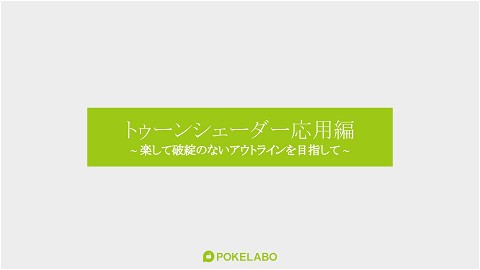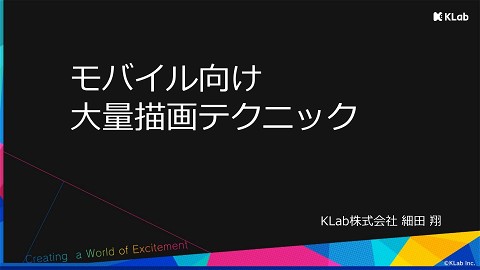【Unite 2017 Tokyo】スクリプタブル・レンダーパイプラインのカスタマイズと拡張
221 Views
June 07, 17
スライド概要
講演者:Jean-François F Fortin(Unity Technologies)
こんな人におすすめ
・スクリプト可能なレンダーパイプラインを学びたいプログラマー
受講者が得られる知見
・レンダリングパスを加える方法
・バッファを微調整し、自分のデータを加える方法
・スクリプト可能なレンダーパイプラインで、シェーダーを作成する方法
講演動画:https://youtu.be/TtTy35ICA7w
リアルタイム3Dコンテンツを制作・運用するための世界的にリードするプラットフォームである「Unity」の日本国内における販売、サポート、コミュニティ活動、研究開発、教育支援を行っています。ゲーム開発者からアーティスト、建築家、自動車デザイナー、映画製作者など、さまざまなクリエイターがUnityを使い想像力を発揮しています。
関連スライド
各ページのテキスト
Scriptable Render Pipelines
Jean-François F Fortin Graphics Expert, Field Engineer, Unity Technologies
Unity’s Current Render Pipeline • Forward or deferred. • Different options available to tweak the rendering: • - Custom shaders for surface and lighting • - Command buffers • - Compute shaders • - Post-processing effects • Works well on multitude of platforms.
In Practice… • Hard to configure for your needs. • Different rendering techniques • Different platforms: • - Different platform strengths • - Different optimisation strategies
The Flexibility/Extensibility Problem • Not a problem for most users but more advanced teams wants to modify or extend unity’s rendering. • Unity’s rendering pipeline is essentially a black box: • - Documentation, presentations and shader source code available. • - Still difficult to understand without a source code license.
The Problem In Pictures
Goals of The New Pipeline • Need to perform better on modern hardware. • Low-level, performance critical code in C++. • High-level, less performance critical code in C#. • No magic => Open-sourced and available on GitHub. • https://github.com/Unity-Technologies/ScriptableRenderLoop
Goals of The New Pipeline • Possibility to create multiple rendering pipelines • - Built for a specific target in mind: hardware or use case. • - Less compromises, more flexible, more performance. • Easier dealing with backwards compatibility • - Difficult to make changes to rendering. • - Users expect things to continue working.
Examples of Rendering Pipelines • HD: targeting “high end”, modern PC and consoles. • VR: optimized for VR and caching/sharing eye data and different viewport schemes. • Low-End/Mobile: optimized for low-end devices or simpler 2D games.
The New Foundations • Engine: C++, performance critical code • - Culling • - Rendering set of objects with filtering, sorting, and batching. • - Platform abstraction. • User project: C# and shaders, open source • - Camera, light, and shadow setup • - Frame render pass structure and logic • - Shader (including compute) code.
Let’s talk about the HD Render Pipeline
HD Render Pipeline: Current Plans • Provide a built-in render pipeline targeting modern (compute-capable) platforms. • Developed with PC and PS4/XB1 in mind. • Looking at optimizations to include high-end mobile platforms. • - Special interests on techniques that saves bandwidth (like on-tile storage/framebuffer fetch)
HD Render Pipeline: Current Plans • Shaders less reliant on separate shader specializations/variants. • - Uses more static branching. • - Shader specializations/variants only where it makes sense upon profiling on target hardware. • A more up-to-date / state-of-the-art pipeline for high end games. • Released as experimental on GitHub, will have a real release later with one of the next releases.
HD Render Pipeline: Features • GGX with metal and specular parametrization. • Anisotropic GGX • Sub-surface scattering (SSS) and transmission • Fine pruned tiled lighting (FPTL) • Physically-based camera parameters • Supports the post-processing stack • …
Example: Sub-surface Scattering
Let’s look at some example code…
Scriptable Rendering Pipelines is an experimental feature and this is made for 5.6.0f3.
How To Create A Render Pipeline? • Need an asset to bind to the graphics settings. • All rendering goes through the Render function of the interface IRenderPipeline. • public void Render(ScriptableRenderContext context, IEnumerable<Camera> cameras)
What goes in the “Render” function? • Inside the render loop you would typically do: • - Culling for all of the cameras. • - Calls to CommandBuffer to setup global shader properties, render targets, dispatch compute shaders, etc. • - Series of calls to ScriptableRenderContext.DrawRenderers.
Note for the following demos • This is not the recommended way to create new pipelines. • Start from GitHub that corresponds to your unity build. • - Important at this point because of the API changes.
How To Create A Render Pipeline? • What do you get from the GitHub builds? • - Two render loops: • - BasicRenderLoopTutorial • - ScriptableRenderLoop/HDRenderPipeline • - Test scenes.
Demo: How To Create A Render Pipeline?
Simple Rendering Pipeline
Simple Rendering Pipeline
Simple Rendering Pipeline
Simple Rendering Pipeline
Simple Rendering Pipeline
Simple Rendering Pipeline
Simple Rendering Pipeline
Simple Rendering Pipeline
Simple Rendering Pipeline • Even with a simple example we can see that we can control shaders. • - We could provide different shader pass for different pipelines. • - Change shaders for set of objects to provide some sort of shader LOD. • - Change the inputs and outputs of a pass by binding buffers or render targets.
Simple Rendering Pipeline • The C++ parts does the per-object operations. • Written in style targeting higher performance, using packed arrays and multithreading. • - Culling • - DrawRenderers • - DrawShadows
Let’s go back to some code…
Profiling • In ProfilingSample constructor: • When ProfilingSample is being destroyed:
Transparent Objects
Geometry Buffer / Deferred Rendering
Shadows
Shadows: Cascaded Shadow Maps
Shadows: Screen Space Shadows [1/2]
Shadows: Screen Space Shadows [1/2]
What could you build with it next? • Techniques or features not yet supported by Unity. • - New post-processing effects. • - Research for new techniques. • - Implement new shading or lighting algorithms. - Tiled lighting - Forward+ • Platform-specific pipelines.
Summary • We are responsible for culling, and for rendering everything. • Includes per-frame and per-pass shader uniform variables, management of render targets, dispatching compute, etc. • Visible lights and probes can be queried from the cull results. • - Useful for tiled lighting, or other per-object light lights. • No per-object operations, independent of scene complexity. • Download the code on GitHub and start you own pipelines!
Thank you!





